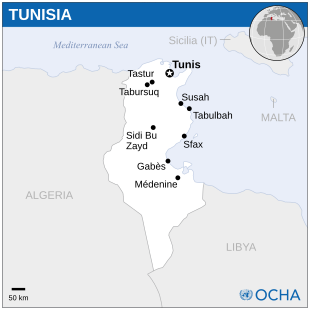More languages
More actions
| Republic of Tunisia الجمهورية التونسية | |
|---|---|
 | |
| Official languages | Arabic |
| Dominant mode of production | Capitalism |
| Government | Unitary semi-presidential republic under a dictatorship of the bourgeoisie |
• President | Kais Saeid |
• Prime Minister | Ahmed Hachani |
| Area | |
• Total | 163,610 km² |
| Population | |
• 2022 estimate | 11,708,370 |
| Currency | Tunisian dinar (TND) |
Tunisia, officially the Republic of Tunisia, is a North African country in the Maghreb region, bordering Algeria and Libya as well as the Mediterranean Sea to the north.
History[edit | edit source]
Antiquity[edit | edit source]
See main article: Carthaginian Empire (814–146 BCE)
Hafsid Kingdom[edit | edit source]
See main article: Hafsid Kingdom (1229–1574)
Ottoman rule (1574-1881)[edit | edit source]
See main article: Eyalet of Tunis (1574–1881)
French colonization (1881-1956)[edit | edit source]
See main article: French protectorate of Tunisia (1881–1956)
Independence[edit | edit source]
After Tunisia achieved independence from French colonial rule in 1956, Habib Bourguiba of the Constitutional Democratic Rally (RDC) took power as a dictator. He ruled until 1981, when Zein al-Abidine Ben Ali pushed him out of power. Ben Ali brutally repressed political opposition, including communists, Islamists, and liberals. Under the RDC's rule, police outnumbered the army three to one and non-party members could not secure animal feed, borrow from banks, or be promoted at their jobs. The European Union and IMF supported Ben Ali's dictatorship.[1]
Protests against Ben Ali's regime begin in December 2010 after Mohamed Bouazizi publicly set himself on fire to protest unemployment. The dictator and his family fled to Saudi Arabia on 14 January and brought over $40 million of gold with them. On 17 January, Prime Minister Mohammed Ghannouchi announced the formation of a National Unity Government similar to the former government.[1]
References[edit | edit source]
- ↑ 1.0 1.1 Harpal Brar (2010-12-01). "Intifada in Tunisia and the fall of Ben Ali" Proletarian. Archived from the original on 2022-05-19. Retrieved 2022-12-18.


